Scroll through the lesson and click on notation/video/audio links to load the interactive players.
Please subscribe to get full access to all lessons for only $7.95/month PLUS 1 week free trial.

Riff Interactive lessons are
LESS expensive and
MORE interactive than alternatives!
More Info
|
|

In The Style of The Edge (U2) - part 1
Lesson Sample
Lyle: The Edge (Dave Evans)
one of rocks most under-rated guitar players, is the guitarist
for the band U2. Edge uses many types of effects, plays
strong rhythm riffs and uses many different guitars, all combined to bring his music many
different sonic textures. To understand one of Edge's most
signature sound or style, you'll need to know a little about his
gear, like guitars, amps and
fx. Here's a picture of his main fx
rack:
rack
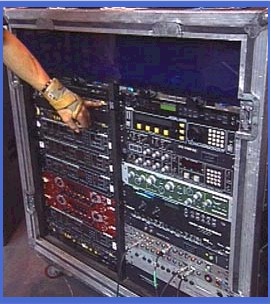
Lyle: It's loaded with enough stuff to launch a
small space shuttle! This rack is filled with digital delays,
compressors and pitch shifters mostly. Very high-tech stuff to produce clean
delays and reverbs just like in a
studio. Edge uses stomp boxes new and old,
here's a look:
pedals 1

Lyle: You can duplicate many of the Edge's fx
settings with your own signal
processors.
pedals
2

Lyle: The Edge uses many old stomp boxes from
his early days so he can still reproduce the same sounds
live.
pedals
3
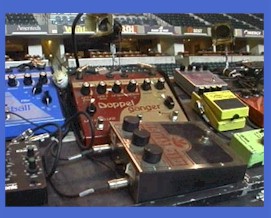
Lyle: Here's a few more
photos:
pedals
6
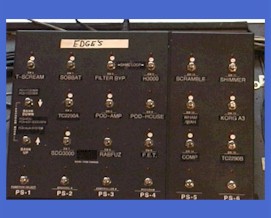
Lyle:
Above is a picture of his switching system near his mic stand. All of his rack fx and all these stomp
boxes are used to create the sounds you hear on all of U2's music and live
shows.
pedalboard 1
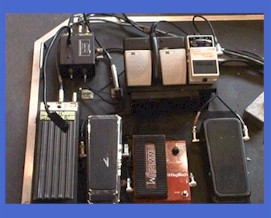
Lyle: In this picture you might see a couple
pedals you know. The white pedal is a Boss
tuner. He's got a wha, volume, Digitech whammy
and a couple of switches for turning the keyboards on and off during live
shows.
Lyle: The Edge uses Vox amps to drive the
signals from all these fx. His favorite is a '64 Vox
AC30.
amp
1
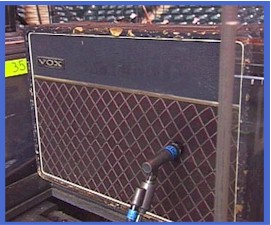
Lyle: He plays mostly Gibson and Fender
guitars. Gibsons for the fat crunch, and Fenders
for the cleaner sounds.
Lyle: Let's check out a few riffs using a
delay setting of 360 milliseconds. First, here's a basic jam track to give
you a beat to work with:
Looping Sound Clip 1
Lyle: Use a clean tone on your amp setting for
this. Watch this video clip of the delay
sound, it's set for about 4 repeats:
echo example 1
Lyle: Turn the output of the delay fx up loud
to match the guitar signal. What is happening here with the jam
track at 125 beats per minute (bpm) and the delay set for 360
ml, is a dotted eighth note
repeat. A very cool
sound.
Lyle: We are using the key of D here and this
next riff is based on the open D string:
Lyle:
You can hear the effect that the echo has at this tempo.
echo
example 2
Lyle: Now you'll add another note to the
riff. You can use all down
strokes. Ok, now add another note like
this:
echo example 3
Lyle: This next example is the D major scale
using this echo effect.
Lyle:
Van Halen used this type of effect in a solo called
"Cathedral". Also David Gilmour used this effect on
the song "Run".
echo example 4 - maj scale
Lyle:
Here's an arpeggio
of the D major scale. An arpeggio is made up from the chord tones of the scale -
1st, 3rd and 5th notes of the major scale.
echo example 5 -
maj arpeggio
Lyle: These have been just examples
of the delay effect used by The Edge on a song that sounds like
this. Play around with your settings on your
signal processors and in the next lesson we'll get into chord progressions and rhythm
techniques. Remember to set your delay to 360 mil
and about 4 repeats that are loud, and jam to the looping sound clip in the key
of D.
Lyle:
That’s all for this lesson.
If you would like further study on this topic or any other topic, email me at
Lyle@theguitar.net for info on how you can get your own customized guitar
lessons like this using Riff Interactive technology. Your private lessons can be
downloaded to your pc for anytime, anywhere study. Thanks and see you at the
next lesson. - Lyle
|
<< load notation from left
|
|
<< load audio from left
|
<< load audio from left
|